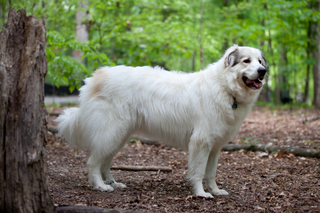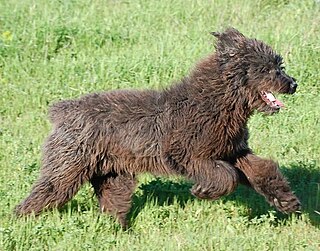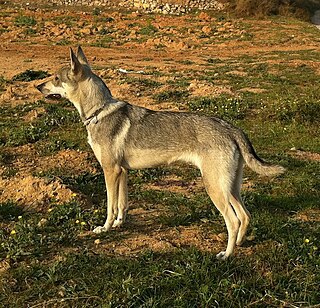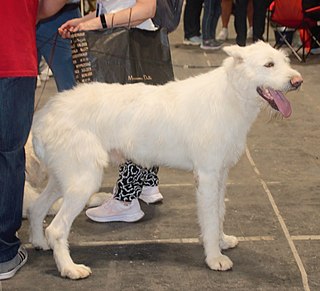
The Pyrenean Mountain Dog or Chien de Montagne des Pyrénées is a French breed of livestock guardian dog; in France it is commonly called the Patou. It originates from the eastern or French side of the Pyrenees Mountains that separate France and Spain and is recognised as a separate breed from the Mastín del Pirineo or Pyrenean Mastiff from the Spanish side of the mountains, to which it is closely related.

The Presa Canario is a Spanish breed of large dog of mastiff or catch dog type. It originates in the autonomous region of the Canary Islands, and is found mostly in the islands of Gran Canaria and Tenerife. It was formerly known as the Dogo Canario. It was traditionally used as a guard dog, as a herding dog for both sheep and cattle, and for dog-fighting, which was legal in Spain until 1936 and may have continued clandestinely thereafter.

The Alano Español or Spanish Bulldog is a Spanish breed of medium to large sized dog of alaunt-bulldog type. It has at various times been used as a war dog, for bullfighting, for the management of cattle, for hunting and as a guard dog.
La Real Sociedad Canina de España is the Spanish kennel club. It was founded in Madrid as the Sociedad Central de Fomento de las Razas Caninas en España on 27 June 1911, and became a legal entity on 12 July 1911; on 1 December 1911 it received the royal patronage of Alfonso XIII, and the word 'Real' was added before the name.

The Ratonero Bodeguero Andaluz is a Spanish breed of dog of the terrier type. Its name reflects its main occupation: hunting rats and mice hidden between barrels in the wineries of Andalusia in Spain. It was recognised as an indigenous Spanish breed in 2000 by the Spanish Ministry of Agriculture and by the Spanish Kennel Club, the Real Sociedad Canina de España.

The Ca de Bou, also known as the Perro de Presa Mallorquin, Mallorca Mastiff or the Majorcan Bulldog, is a breed of bulldog type dogs from Majorca, the largest of the Balearic Islands.

The Basque Shepherd Dog, Basque: Euskal Artzain Txakurra, Spanish: Perro de Pastor Vasco, is a traditional Spanish breed of sheepdog originating in the historic Basque Country. It is believed that they originated from Central European herding dogs.

The Pachón Navarro is a Spanish breed of hunting dog from the autonomous community of Navarre, in northern Spain. It is one of five Basque breeds of dog, the others being the Basque Shepherd Dog, the Erbi Txakur, the Villano de Las Encartaciones and the Villanuco de Las Encartaciones.

Podenco Canario is a breed of dog from the Canary Islands. The Podenco Canario is still used today, primarily in packs, most often for the sport hunting of rabbits. The word "podenco" in Spain refers to a certain type of dog, typically rabbit hunters with the same body shape. "Canario" is a reference to its region of origin, the Canary Islands. The Spanish Kennel Club, Real Sociedad Canina de España, recognises the following similar dog breeds that use the identifier "podenco" in their names: Podenco Andaluz, Podenco Ibicenco, and Podenco Valenciano. ge

The Sardinian Shepherd Dog or Fonni's Dog is an ancient landrace breed of Sardinian dog used as a herding, catching, and livestock guardian dog.

The Villano de Las Encartaciones is a Spanish breed of large working dog from the region of Las Encartaciones in the province of Biscay, in the Basque country; it is found also in Álava, in eastern Cantabria and in northern Burgos. The traditional use of the dogs is in management of the Monchina breed of cattle of Cantabria and the País Vasco, and particularly to assist with bringing the cattle down from the mountain pastures between October and December. In 2009 there were fewer than 200 dogs registered in the studbook.

The Can de Palleiro is a traditional Spanish breed of shepherd dog from the autonomous community of Galicia in north-western Spain. It was recognised by royal decree in 2001, and the stud-book was established in the same year. It is named after the haystack near which it traditionally sleeps.

The Podenco Andaluz is an ancient Spanish breed of warren hound used to hunt small game in Andalusia, Spain. It is one of four podenco breeds recognized by the Real Sociedad Canina de España. It is an agile dog generally used to hunt ducks, rabbits, boar and fowl. There are three accepted sizes and three coat types.

The Ratonero Valenciano, also known as the Gos Rater Valencià, is a breed of dog that originates in Spain. Recognised by the Real Sociedad Canina de España in 2004, it has had recent success with a member of the breed winning the Spanish National Dog Show in 2011. It is a traditionally docked breed. In 2022, the FCI finally recognised the breed, naming it rather "Terrier" than "Ratter".

The Pastor Garafiano is a Spanish breed of sheep dog native to the island of La Palma in the Canary Islands. The name comes from the comarca of Garafía, in the north of the island, where the breed was most common, although specimens can be found throughout the island. The breed was officially recognized by the Real Sociedad Canina de España in 2003.

The Maneto is a dog breed native to Andalusia in Spain. It is derived from the medium-sized Andalusian Hound, and is used to hunt rabbits, partridge, quail, and for retrieving ducks from the water. Its legs are short relative to its body, and its ears are triangular and blunt. The breed is recognised by the name Maneto by the Real Sociedad Canina de España. The word "maneto" in Spanish indicates an impediment or defect in any of the hands or legs.

The Podenco Valenciano, also known as the Xarnego Valenciano or Gos Coniller, is a warren hound originating in Valencian Community, Spain. It was officially recognized by the Real Sociedad Canina de España in 2017.

The Lobito Herreño or Perro de Pastor Herreño is a Spanish breed or type of pastoral dog. It is found mostly on the island of El Hierro in the Canary Islands, but also on Gran Canaria, La Palma and Tenerife. It is not recognised as breed by the Real Sociedad Canina de España, but in 2021 was one of three breeds or types listed as a grupo étnico canino, which the society defines as a regional dog population with consistent form and function evolved through functional selection. The other two dogs in this group are the Podenco Orito Español and the Carea Castellano-Manchego.

The Valdueza or Perro Montero Valdueza is a modern Spanish breed of large pack-hound. It results from selective breeding, principally of large rough-haired Podenco Andaluz dogs with lightweight examples of the Mastín Extremeño; some Griffon Vendéen blood was later added. Breeding began in the 1940s; in 2020 the Valdueza was officially recognised by the Ministerio de Agricultura, Pesca y Alimentación, the Spanish ministry of agriculture, and was added to the list of indigenous Spanish breeds. It is not recognised by the Fédération Cynologique Internationale.


















